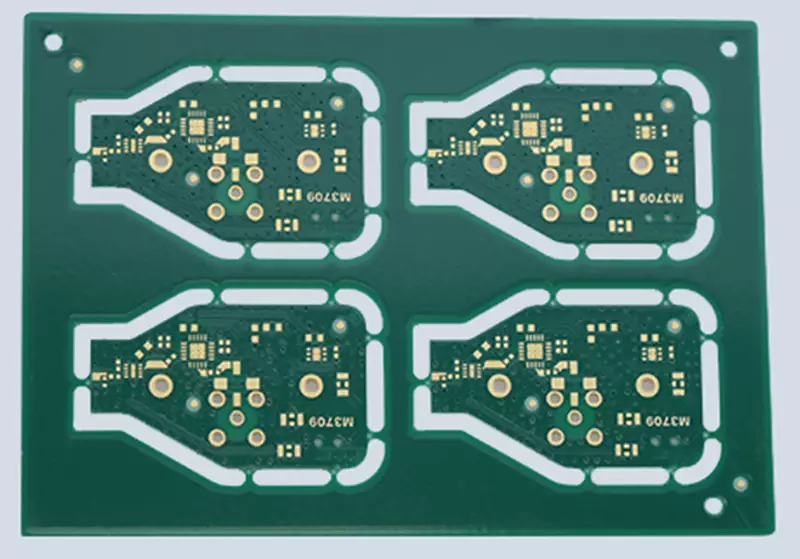Examples of robots used in PCB manufacturing
1. Six axis multi joint robot for AOI detection process
Traditional AOI scanners rely on manual loading, flipping, and unloading. Two machines are guarded by one person, repeating monotonous actions every day. The newly produced circuit board emits a pungent odor to the human body. The infrared light emitted by AOI scanners can cause certain damage and is also an invisible killer. Let's use a six axis multi joint robot instead of a worker to load, flip, and unload two AOIs. Each shift can complete the feeding and unloading of over 700 PCB hard boards, with a total power of up to 1 piece per minute (including AOI machine scanning time). If the loading and unloading transport line that cooperates with the retractable board machine can be further connected to the AGV for fixed line transfer,
2. SCARA robot is used for circuit board coil detection process
At present, there are few complete detection devices for short circuits in multi-layer coil on the market. Most detection equipment relies on manual labor. The large aperture PCB board is manually placed on the testing equipment and then opened for testing. PCB boards with small apertures require manual gripping of the device (probe) to test each coil. We can use SCARA robots to complete the loading, unloading, and alignment of collaborative inspection equipment, and complete the inspection of all rolls of large aperture plates in one go. For small aperture plates, we use SCARA equipment to fix the probe at the end and visually locate it., By using probes to detect each coil, our equipment effectively prevents false detections caused by coil diameters that are too small or too large during manual operation.
3. DELTA robot is used for the packaging process of small circuit board products
The existing FPC trays are manually picked up one by one and placed in vacuum formed trays. Because FPC is soft and thin, it is not convenient to pick up, so the power will be greatly reduced. Delta800, combined with a visual system, can select qualified FPCs from a pile of FPCs and place them in vacuum trays according to requirements, which is not inferior to manual labor. His speed can reach 60 pieces per minute, which can completely replace manual sorting and loading.

PCB
The advantages of industrial robots replacing manual labor in the PCB industry
1. Reduce manual labor, accelerate work cycles, and improve work motivation. Robots can complete high-speed repetitive tasks that are much longer than manual work cycles, resulting in a significant increase in work power and a reduction in labor and processing costs.
2. Improve operational accuracy and enhance product quality. Robots can achieve precise positioning and repeatability through programming and visual systems, effectively improving product quality.
3. Prevent potential threats to workers' health and safety from the working environment, and save on environmental safety investments.
4. Reduce the power and quality degradation and accident rate caused by repetitive and monotonous processes on workers' conditions.
5. Optimize workflow and reduce workspace.
6. Effectively reduce material consumption rate.
7. Can work continuously 24 hours a day in low light environments.
8. It can make the production process flexible. In the future, the PCB industry will see an increasing number of small batch orders. The use of industrial robots can greatly improve the flexibility of production and achieve rapid delivery of orders.
9. Improvement of brand image and reputation. The application of industrial robots has further improved the automation level of PCB manufacturers, promoted the improvement of product quality, production capacity, cost control, and responsiveness, and enhanced the overall competitiveness of industry manufacturers.
In the future, the application of industrial robots in the PCB industry will present the following trends
1. From single station or single line applications to multi line applications. Existing PCB companies find it difficult to fully introduce robots for automated production and require significant investment in renovation. However, it is possible to gradually expand the scope of single station and single line renovation that meets the conditions and achieve significant results before applying.
2. From simple robot usage to integration with other intelligent devices such as AGVs. Most of the material transfer between existing production lines is manually operated, which can be achieved through the combination of robots and AGVs to achieve orderly material transfer.
3. The existing factory mainly focuses on partial applications, while the new factory is planned and constructed as a whole, with direct introduction of robots and AGV applications.
4. The combination of industrial robots and the Internet of Things will make the production process more intelligent and flexible.
In summary, it can be foreseen that the PCB industry will use industrial robots on a large scale in the future.
Prospects of Industrial Robots in PCB Industry Application
The application of industrial robots in PCB is just beginning and still faces many problems that need to be solved. Many production lines in the PCB industry are non-standard products. In the process of robot application, they are limited by the existing workspace and primitive equipment capabilities. Faced with the influence of different PCB material elements, it is necessary to consider the use of various sensors in order to move forward. The intelligence of robots must also consider cultivating a group of workers for manufacturers who can operate and protect robots.